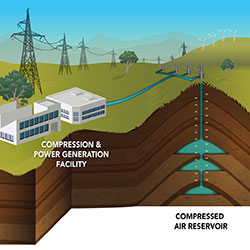Compressed Air Energy Storage
In the first project of its kind, the Bonneville Power Administration teamed with the Pacific Northwest National Laboratory and a full complement of industrial and utility partners to evaluate the technical and economic feasibility of developing compressed air energy storage (CAES) in the unique geologic setting of inland Washington and Oregon. The basic idea of CAES is to capture and store compressed air in suitable geologic structures underground when off-peak power is available or additional load is needed on the grid for balancing. The stored high-pressure air is returned to the surface and used to produce power when additional generation is needed, such as during peak demand periods. To date, there are two operating CAES plants in the world; a 110 MW plant in McIntosh, Alabama, commissioned in 1991 and a 290 MW plant in Huntorf, Germany built in 1978. Both plants store air underground in excavated salt caverns produced by solution mining. Since underground salt formations are in relatively few locations geographically and are specifically not present in the Pacific Northwest, the project team extended analysis of traditional CAES storage in salt caverns to much more prevalent underground porous and permeable rock structures. Doing so resulted in a set of significant advancements to CAES concepts and to its fundamental value proposition beyond traditional peak to off-peak load shifting. Details regarding the project's assumptions, analysis methods, and findings are provided in the Executive Summary and in the main body of this report. However, the key overarching conclusions from this study are:
- Eastern Washington and Oregon are rich with potentially suitable sites for CAES. Screening criteria were applied to identify more favorable site locations and included constraints on distance to both natural gas pipelines and transmission lines (230 kV or greater), presence of deep, thick, and laterally extensive geologic traps, and proximity to previously drilled deep exploration wells to constrain storage reservoir properties. Application of the screening criteria yielded five candidate locations, which were narrowed to two areas for detailed assessment of subsurface storage capacity, power plant design, transmission interconnection, and economic feasibility.
- A conventional CAES plant was designed and analyzed for a first site located at Columbia Hills. The plant design offers 231 MW of load during storage and 207 MW of generation. Storage capacity at this site was estimated at approximately 1.5 million metric tons of air, representing potential for approximately 40 days of continuous injection at plant capacity and simulations indicate a capability of over 400 hours of subsequent generation without further injections. Simplified economic analysis indicates the installed capital cost would be similar to conventional combined-cycle gas turbines at a levelized cost of electricity (LCOE) as low as 6.4 cents per kilowatt-hour (kWh), competitive with most generating options within the region.
- A new type of no-fuel hybrid geothermal CAES plant was designed for a site located near Yakima Canyon north of Selah (Yakima Minerals). Constraints on natural gas supply were identified after this site was selected, which necessitated development of this new CAES plant configuration. The plant design at this location offers 150 MW of load during storage and 83 MW of generation capacity. The storage reservoir at this site is very deep, being more than 10,000 ft below ground surface. Pressures at those depths result in higher density of air being stored, which combined with a very large reservoir structure provide for a very large air storage capacity. Simulations of continuous injection for 1 year representing 4 MMT of air filled less than 20% of the reservoir volume. The hybrid Yakima Minerals plant LCOE was estimated to be 11.8 cents per kWh and could be competitive with the region’s peaking and renewables generation.
- Both plant configurations evaluated would be capable of providing balancing (increasing or decreasing reserve), energy production, and peaking capacity within ten minute response time standards.
Utilization of the very large air storage capacity available in porous rock structures enables a CAES plant to offer a unique combination of attributes including grid-scale energy storage capacity, seasonal load shifting, load balancing, peaking reserve, and traditional diurnal peak to off-peak load shifting. CAES appears to offer a storage and generation option that could integrate well into the region's resource portfolio, with the ability to tailor plant design, storage reservoir siting and development, and project management to the operator's specific needs and business case.

